Isadore J. and Lucille Zimmerman House
Of all the private homes I’ve seen that were designed by Frank Lloyd Wright, this is the one I’d most like to reproduce and live in. Built for a doctor and his nurse wife in 1950, the house is located in Manchester, New Hampshire. It’s owned by the Currier Museum of Art. I saw the house in the early spring of 2000. The above photo is of the back – for some reason I didn’t take a full-length of the front.
If you take a tour, there are a couple annoying aspects: 1) no interior photography and 2) being forced to stand around in the living room and listen to some guy play Kenny G-type crap on the guitar. You can see a few interior shots at Currier’s website. Here’s one of my shots of the front.
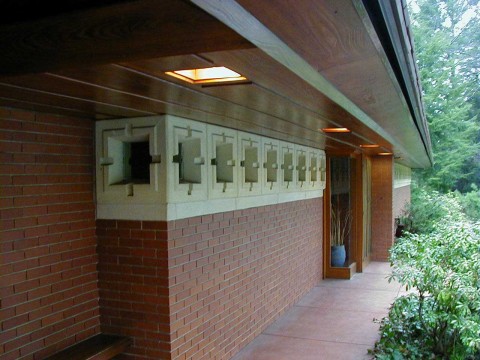 Interesting that Wright uses something similar to his textile blocks to decorate the front. In this case, there are panes of glass in each block to let in light.
Interesting that Wright uses something similar to his textile blocks to decorate the front. In this case, there are panes of glass in each block to let in light.
Here’s a wider shot of the front:
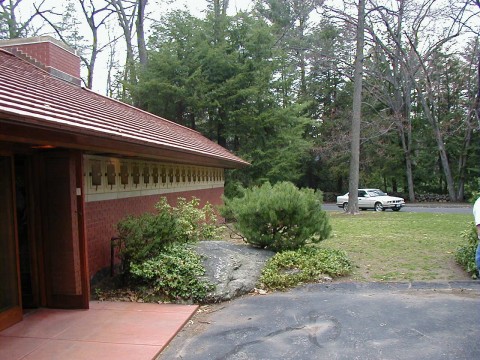 What impressed me the most, aside from the sheer livability of the home, was the craftsmanship and attention to detail. Look at the way the roof was installed:
What impressed me the most, aside from the sheer livability of the home, was the craftsmanship and attention to detail. Look at the way the roof was installed:
As usual, there is a carport (Wright refused to design garages – he thought you’d just fill them with crap):
Wright even designed the mailbox:
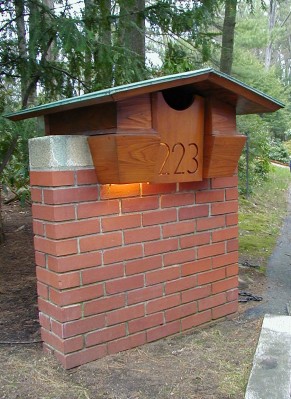 Like the Kaufmans, who owned Fallingwater, the Zimmermans loved their house so much that they had their ashes interred on the grounds (sorry for the crap photo):
Like the Kaufmans, who owned Fallingwater, the Zimmermans loved their house so much that they had their ashes interred on the grounds (sorry for the crap photo):
Some aerial shots of the *opposite* of Wright’s ideas about land use (from FL):
http://www.boston.com/bigpicture/2010/09/human_landscapes_in_sw_florida.html
It’s got to be weird being the owner of the house in the lower left of #15 – nothing but empty street all around.
I like the outside of the house better than the inside — too much brick inside. The wood is beautiful.
Given Wright’s very utilitarian aesthetic, I’m not so sure he would disapprove of many of the developments pictured at al203cr’s link.
It is too bad though that some of the “blocks” in the large developments weren’t set aside for commercial uses. Compact mixed-use development is the way to go.
@al2o3cr: nice to be all alone out there, but the question is: who takes care of all those lots? what if they’re overgrown, swampy …?
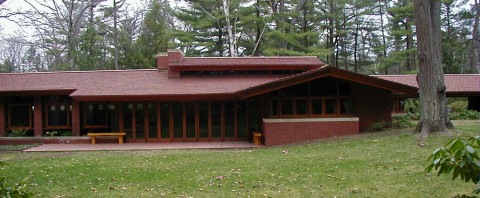
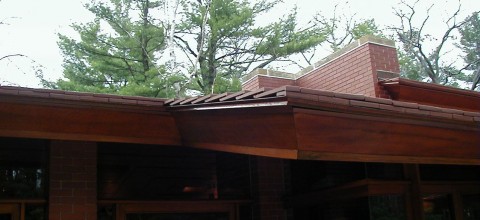
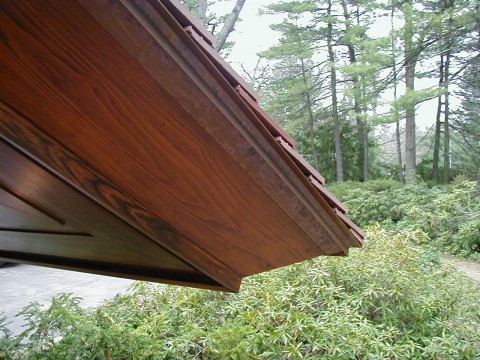
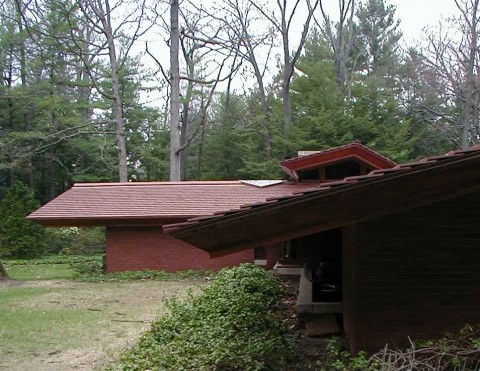
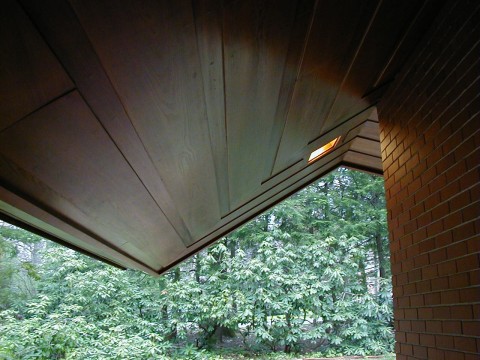
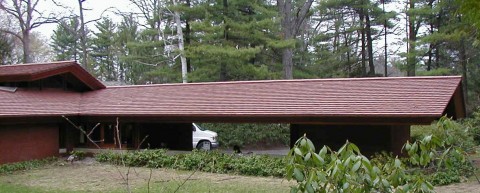

MANCHUCANDIDATE • Weeping Angel Imagine going from hope to Fascism in less than two decades enabled by greedy ass (millionaire)…
NOJO • Nightmare at the Museum From the last time he threatened to bomb Iran, 2020. Remember that one? All a misty blur now.
NOJO • TRUMP TARIFFS UNLEASHING FURY OF CANADIANS - AND THEIR LEGENDARY SNIPERS! @ManchuCandidate: I have birthright citizenship in Cascadia, so I think I’m good.
MANCHUCANDIDATE • TRUMP TARIFFS UNLEASHING FURY OF CANADIANS - AND THEIR LEGENDARY SNIPERS! @nojo: Only the sane parts... like the West coast, New England (minus the Bruins and…
NOJO • TRUMP TARIFFS UNLEASHING FURY OF CANADIANS - AND THEIR LEGENDARY SNIPERS! @ManchuCandidate: So, can you guys annex us now?
MANCHUCANDIDATE • TRUMP TARIFFS UNLEASHING FURY OF CANADIANS - AND THEIR LEGENDARY SNIPERS! PP is done. 51st state, my ass.
NOJO • TRUMP TARIFFS UNLEASHING FURY OF CANADIANS - AND THEIR LEGENDARY SNIPERS! @FlyingChainSaw: No, but my government was.
FLYINGCHAINSAW • TRUMP TARIFFS UNLEASHING FURY OF CANADIANS - AND THEIR LEGENDARY SNIPERS! @nojo: Were you kidnapped?
NOJO • TRUMP TARIFFS UNLEASHING FURY OF CANADIANS - AND THEIR LEGENDARY SNIPERS! @FlyingChainSaw: I’ve spent the past five weeks looking like Astronaut Dave going through the…
FLYINGCHAINSAW • TRUMP TARIFFS UNLEASHING FURY OF CANADIANS - AND THEIR LEGENDARY SNIPERS! NOJO - HOW COME WE'RE NOT COVERING KRASNOV?